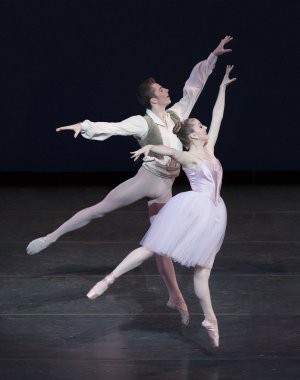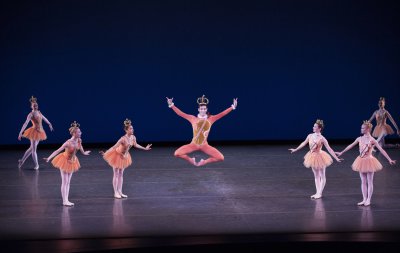The School of American Ballet 2015 Workshop Performances
Brimming with joy and enthusiasm, these performances inspire optimism for the future of classical ballet.

Kennard Henson and Larisa Nugent in Balanchine’s “William Tell” Pas de Deux (Photo credit: Paul Kolnik)
[avatar user=”Joel Benjamin” size=”96″ align=”left” ] Joel Benjamin, Critic[/avatar] The annual School of American Ballet Workshop performances are more than occasions for fundraising. They are a chance to see the next generation of classical ballet dancers in what we hope will soon be their native habitat, the stage. The programs are optimism incarnate, an opportunity to believe in the future of dance.
“Harlequinade,” to bouncy music by Riccardo Drigo, is George Balanchine’s gift to young students who get a chance to wear colorful costumes and show their enthusiasm and discipline. There were the Polichinelles, the youngest kids (eight years old, or so), in their golden, humpbacked outfits and the Harlequins with their diamond-patterns tight. The slightly older students were Pierrettes (white tutus) and Pierrots (absurdly long-sleeved white costumes) and the Scaramouches (dashing, dark outfits). The steps were simple walks, prances, pirouettes, with some light partnering thrown in. What was remarkable was how these youngsters instilled these steps with joy and how seamlessly they moved from one stage pattern to the next. Dena Abergel and Arch Higgins, who staged the ballet, have to be credited with drawing such musical performances from these kids.
This season, the New York City Ballet has staged an all-Bournonville program so it was apt that the SAB workshop should get his “William Tell” Pas de Deux, staged by Darci Kistler with an eye for every detail. Bournonville ballets are the backbone of the Royal Danish Ballet repertoire with their intricate footwork, simple, open arms and lovely partnering. Larisa Nugent and Kennard Henson acquitted themselves well in this flirtatious duet with its constant, twisty changes of direction. His solo was highlighted by repeated entrechats (vertical leg beats) and hers, delicate traveling steps on point. They weren’t totally at ease in this style, but communicated the sweet flirtatiousness of the steps.
The “Sleeping Beauty” Pas de Deux is probably the most classical of pas de deux. Originally created by Marius Petipa, this version was choreographed by Peter Martins and was staged here by Yvonne Borree and Jonathan Stafford. Sasonah Huttenbach and Alec Knight were challenged by the difficult partnering demands, which include the famous “fish” dives in which the ballerina falls over the danseur’s outstretched leg, arching her back, her legs held high. Mr. Knight’s attention kept wandering from his “bride” toward the audience. His solo was elegant, but simplified. Ms. Huttenbach performed her long solo with panache, although a bit more use of the shoulders would have given her dancing some color. This is one difficult work that has challenged generations of the greatest dancers and these two made a game effort.
“Valse Fantaisie” by Balanchine to music by Mikhail Glinka is a wind-swept, swiftly moving work pitting a couple against a female quartet. The four women—Constance Doyle, Rachel Hutsell, Courtney Nitting and Samantha Riester—in their fluffy, long pale tutus flew about the stage, framing the lead couple, Leah Christianson and Thomas Davidoff. Mr. Davidoff, long-legged and elegant, partnered Ms. Christianson well and bounded through his solos. Ms. Christianson, however, is a star in the making. Her physique is not in the usual Balanchine mold of long and lean, but she took the stage with energy and a mature musicality. She was a delight. Suki Schorer staged this ballet, instilling these dancers with the Balanchine style.
An excerpt from Balanchine’s paean to his adopted country, “Stars and Stripes,” to music by John Philip Sousa, was a pleasure from beginning to end as staged by Jock Soto. The twelve-member all-male corps de ballet was led by an effervescent soloist, Xhosa Scott. The operetta-like blue uniforms, complete with funny hats, looked terrific on these young dancers as they zipped through double-air turns, marched in complex formations and exuded patriotism. Mr. Scott, small and quick, is another star in the making with his soft, high jumps, tossed off turns and youthful demeanor.
He also appeared in the final work of the evening as one of a pair of witty bassoons in Jerome Robbins’ staging of Benjamin Britten’s “The Young Person’s Guide to the Orchestra” called “Fanfare.” Each section of the orchestra—woodwinds, strings, brass and percussion—is illustrated choreographically. Hosted by a Major Domo, David Lowenstein in a hilarious Beefeater costume, the work began with a statement of the Henry Purcell theme as each fantastically costumed section entered: the woodwinds in pale blue, strings in shades of pink, brass in yellow and percussion in black, all topped off with cartoony headgear.
Each instrument within each section—e.g. flutes, oboes, etc.—was danced separately, then coalesced into little section codas, with all the dancer/instruments gathering on stage for a wonderfully complex finale. The three-men percussion team—Ethan Fuller, Marc LaPierre and Alexandros Pappajohn—were the standouts with their pseudo-macho, tough guy demeanor. The Fugue, with its stirring re-statement of the Purcell theme, filled the stage with this large cast. “Fanfare” was a perfect work for these young dancers, testing their techniques and their acting abilities in equal measure.
With a rich and varied repertoire, the SAB Workshops are far more than end-of-the-year recitals. This 2015 edition showcased the high quality of the School of American Ballet’s training and the promise of the young dancers.
The School of American Ballet 2015 Workshop Performances (May 30 – June 2, 2015)
Peter Jay Sharp Theater at the Juilliard School, 155 West 65th Street, in Manhattan
For tickets and information about upcoming activities visit http://www.sab.org/workshop
Running time: 90 minutes including one intermission








Leave a comment